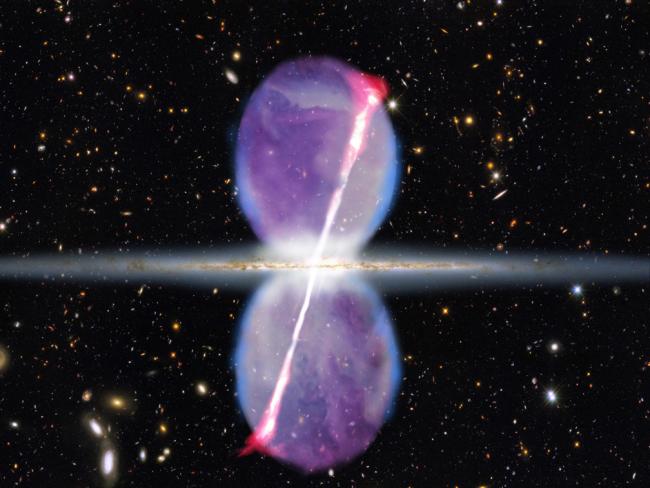
An artist's conception of newly discovered gamma-ray jets (pink) coming from the massive black hole at the center of the Milky
Way. The jets extend for 27,000 light-years above and below the galactic plane. Previously known gamma-ray bubbles are shown in purple.
Supermassive black holes, some as massive as ten billion solar masses, are believed to lie at the nuclei of most
galaxies. Radio observations have found jets of fast-moving charged particles emanating from the nuclei of many such galaxies and extending across tens of thousands of light-years. They are thought to be the result of accreting matter onto the black hole. These jets inject
significant amounts of energy into the medium, sometimes creating a hot
cocoon. The mechanism by which these jets turn on and off is one of the major
puzzles in high energy astrophysics, but in some cases the jets may have been produced continuously for tens of millions of years.
The black hole at the center of the Milky Way is, at least for the moment, in a quiescent state. It has no known jets and shows no signs of dramatic activity -- but it may not have been so passive in the past. In fact, it would be strange if the Milky Way's black hole did not in general behave like the black holes in other galaxies and have episodes of activity.
CfA astronomers Meng Su and Doug Finkbeiner combed through gamma-ray
images obtained recently by the Fermi Space Telescope, looking for evidence of past activity from the Milky Way's black hole. Two years ago the scientists discovered two superbubbles of hot gas extending outward from the nucleus, presumably the result of some kind of previous black hole activity. By very carefully subtracting the gamma-ray images of these bubbles from the faint, diffuse gamma ray sky emission, the
astronomers discovered residual evidence of a narrow but gigantically long structure - about 27,000 light-years - extending in both directions from the plane of the galaxy. Moreover, the scientists suggest a
plausible but unconfirmed scenario in which both the superbubbles and the jets were produced by accretion around the black hole during a more active epoch. If these results are confirmed, the new paper not only sheds important light on the history of our galaxy's activity, it is the
first time images of jets have ever been seen in the gamma-rays.
Related News
CfA Scientists Play Important Role in New NASA Mission
Runaway Stars Reveal Hidden Black Hole In Milky Way’s Nearest Neighbor
CfA Celebrates 25 Years with the Chandra X-ray Observatory
CfA Astronomers Help Find Most Distant Galaxy Using James Webb Space Telescope
Unexpectedly Massive Black Holes Dominate Small Galaxies in the Distant Universe
Distant Stars Spotted for the First Time in the Vast Magellanic Stream
CfA Scientists Help Reach New Milestone in Quest for Distant Galaxies
Astrophysicists Hunt for Second-Closest Supermassive Black Hole
The Tilt in our Stars: The Shape of the Milky Way's Halo of Stars is Realized
JWST Draws Back Curtain on Universe's Early Galaxies
Projects
2MASS Redshift Survey
AstroAI
Dark Energy Spectroscopic Instrument (DESI)
GMACS
For Scientists